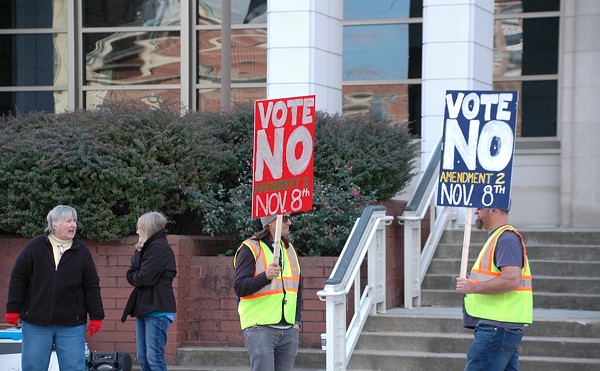
Even though they work in a grocery store, full of things to eat, more than 75% of Kroger employees meet the U.S. Department of Agriculture's definition of "food insecure," according to a new report.
A survey of more than 10,000 Kroger employees from Washington State, Colorado and California — conducted by research group the Economic Roundtable and funded by United Food and Commercial Workers Union (UFCW) — found that "the living and working conditions of Kroger workers have declined markedly over the past 20 years."
"These workers cannot afford balanced and healthy food. They run out of food before the end of the month, skip meals, and are hungry sometimes," reads the report. "Those with children report they go hungry to provide food and other essentials for their children. Kroger workers’ exceptionally high rate of food insecurity is seven times greater than the U.S. average."
Kroger provides a 10% discount on its house brand items, but that does not include fresh produce, according to Economic Roundtable.
The USDA defines food insecurity as follows:
Low food security: reports of reduced quality, variety, or desirability of diet. Little or no indication of reduced food intake.
Very low food security: reports of multiple indications of disrupted eating patterns and reduced food intake.
Kroger, which is headquartered in Cincinnati, is the largest supermarket chain in America. The workers who answered the survey were employed by supermarkets Kroger owns, including Ralphs, Fred Meyer and King Sooper. In addition to food insecurity, employees also answered questions about wage, working conditions and housing.
Some big takeaways from the survey include:
- "Nearly two-thirds of Kroger workers say they do not earn enough money to pay for basic expenses every month." Economic Roundtable says full-time Kroger employees would have to earn $22 per hour, or $45,760 per year, to make a living wage, but the average annual amount an employee makes is $29,655.
- "14% of Kroger workers are homeless now or have been homeless during the past year." Housing insecurity was most prevalent among low-wage, part-time employees as well as those who identified as Black, Native American and Latino. However, Economic Roundtable says 15% of full-time workers also couldn't afford to pay their rent or mortgage.
- "73% of Kroger workers say they are not fairly compensated based on their experience and the work that they do." And two-thirds said the company has increased the amount of work they have to do during their shift.
- "More than two-thirds of Kroger workers struggle for survival due to low wages and part-time work schedules." Nine out of 10 of those surveyed said their pay has not increased proportionately to the increase in cost of basic necessities including food and shelter. And Economic Roundtable says only 30% of positions are full-time.
- "Over half of Kroger workers have work schedules that change at least every week, and 13% have schedules that change every day." According to Economic Roundtable, 25% of those are informed about their schedule changes the same day or only a day in advance. This unpredictability has a major impact on workers' lives, including issues with finding childcare.
- "The number of workers leaving Kroger has increased four-fold since the onset of COVID. " Employees have left the company because of concerns about safety and to look for better jobs. They also had concerns about staffing issues. The report says Kroger's understaffing affects food handling, cleaning and the health and safety of customers.
- "Over two-thirds of the workers report having difficult experiences with customers during the pandemic." Those experiences include issues with customers who refused to wear masks or social distance. In addition, 25% of workers were threatened with violence, and more than 20% reported violent incidents in their stores. The report also says in a majority of cases, store managers did not step in to help employees who were "confronted by abusive or violent customers."
- Those surveyed in the report also said that managers displayed favoritism among employees and also retaliated against others. A third of them said that retaliation took the form of scheduling changes.
- More than 75% of Kroger workers said their "workplace stress follows them home in the form of ongoing depression and anxiety."
According to an article on the report from In These Times, while employees were experiencing these issues, Kroger continued to grow its revenue and profits.
"Kroger, which employs close to a half million people, sold more than $132 billion in groceries in 2020, with profits of $4 billion. Since the beginning of the pandemic, Kroger’s stock has risen more than 40%," reads the article. "The desperate situation reported by its work force illustrates the extent to which – even in unionized stores – grocery industry profits flow to investors and management, rather than to workers."
Economic Roundtable writes, "The pay for Kroger’s CEO has increased 296% over the past decade and is now 909 times greater than the median pay for company employees. This is one of the largest CEO-worker pay gaps of any major American company." It also reports that the company's stock buyback program helped benefit its shareholders but not its workers. While Kroger did enact hazard pay for floor workers at the start of the pandemic, that increase only lasted a couple of months.
A Kroger spokesperson told In These Times, “Since 2017, we’ve invested significantly to increase our national average hourly rate of pay from $13.66 to $16.68, reflecting an increase of $3 per hour or simply stated as a 22% increase… As America’s grocer, we have balanced significant wage investments for our associates while keeping food affordable for the communities we serve.” Despite those issues, Economic Roundtable found that Kroger employees — especially those who are older and have been working for the company for a longer time — take pride in their work and have strong bonds with their co-workers. And it made a list of recommendations for how Kroger could improve the lives of its employees including increasing pay to an annual rate of $45,760, upping the amount of full-time positions from 30% to 60%, providing housing assistance and offering a 50% discount on food.
Read the full report at economicrt.org.
Sign up for our weekly newsletters to get the latest on the news, things to do and places to eat delivered right to your inbox.





